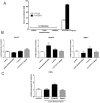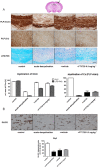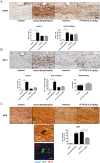The sphingosine 1-phosphate receptor agonist FTY720 is neuroprotective after cuprizone-induced CNS demyelination
- PMID: 25220526
- PMCID: PMC4280969
- DOI: 10.1111/bph.12938
The sphingosine 1-phosphate receptor agonist FTY720 is neuroprotective after cuprizone-induced CNS demyelination
Abstract
Background and purpose: Modulation of the sphingosine 1-phosphate receptor is an approved treatment for relapsing multiple sclerosis because of its anti-inflammatory effect of retaining lymphocytes within the lymph nodes. Here, we evaluated the potential of an agonist at this receptor, FTY720 (fingolimod), to activate the promyelinating pathways within the brain to encourage remyelination and neuroprotection.
Experimental approach: In this study, we used the cuprizone model in male C57BL/6 mice and tested the promyelinating and neuroprotective effects of FTY720 after acute and chronic toxin-induced experimental demyelination. We used histological, immunohistochemical and gene expression methods.
Key results: The midline of the corpus callosum was severely demyelinated after acute and chronic cuprizone-induced demyelination. Robust endogenous remyelination was evident after acute, but impaired after chronic, demyelination. FTY720 treatment modestly accelerated myelin recovery after acute but not chronic cuprizone exposure. Markers of gliosis (astrocyte and microglia activation) were not affected by FTY720 treatment. Remarkably, the accumulation of amyloid precursor protein-positive spheroids in axons was less distinct in FTY720-treated animals, indicating that this compound alleviated ongoing axonal damage.
Conclusions and implications: We show that even during endogenous remyelination, axonal degeneration continued at a low level, accumulating over time. This continuous neurodegenerative process was ameliorated by FTY720 treatment. FTY720 preserved CNS integrity by direct interaction with brain resident cells, the actions of which are still to be defined.
© 2014 The British Pharmacological Society.
Figures




Similar articles
-
Neurobiological effects of sphingosine 1-phosphate receptor modulation in the cuprizone model.FASEB J. 2011 May;25(5):1509-18. doi: 10.1096/fj.10-173203. Epub 2011 Jan 19. FASEB J. 2011. PMID: 21248243 Free PMC article.
-
Functional antagonism of sphingosine-1-phosphate receptor 1 prevents cuprizone-induced demyelination.Glia. 2018 Mar;66(3):654-669. doi: 10.1002/glia.23272. Epub 2017 Nov 29. Glia. 2018. PMID: 29193293 Free PMC article.
-
Fingolimod does not enhance cerebellar remyelination in the cuprizone model.J Neuroimmunol. 2015 Aug 15;285:180-6. doi: 10.1016/j.jneuroim.2015.06.006. Epub 2015 Jun 19. J Neuroimmunol. 2015. PMID: 26198937
-
FTY720 (fingolimod) in Multiple Sclerosis: therapeutic effects in the immune and the central nervous system.Br J Pharmacol. 2009 Nov;158(5):1173-82. doi: 10.1111/j.1476-5381.2009.00451.x. Epub 2009 Oct 8. Br J Pharmacol. 2009. PMID: 19814729 Free PMC article. Review.
-
Central effects of fingolimod.Rev Neurol. 2014 Aug 1;59(3):121-8. Rev Neurol. 2014. PMID: 25030072 Review. English, Spanish.
Cited by
-
Motor Behavioral Deficits in the Cuprizone Model: Validity of the Rotarod Test Paradigm.Int J Mol Sci. 2022 Sep 26;23(19):11342. doi: 10.3390/ijms231911342. Int J Mol Sci. 2022. PMID: 36232643 Free PMC article. Review.
-
G-Protein-Coupled Receptor Gpr17 Expression in Two Multiple Sclerosis Remyelination Models.Mol Neurobiol. 2019 Feb;56(2):1109-1123. doi: 10.1007/s12035-018-1146-1. Epub 2018 Jun 5. Mol Neurobiol. 2019. PMID: 29873041
-
Multiple sclerosis animal models: a clinical and histopathological perspective.Brain Pathol. 2017 Mar;27(2):123-137. doi: 10.1111/bpa.12454. Epub 2017 Jan 11. Brain Pathol. 2017. PMID: 27792289 Free PMC article. Review.
-
Oral Therapies for Multiple Sclerosis.Cold Spring Harb Perspect Med. 2019 Jan 2;9(1):a032011. doi: 10.1101/cshperspect.a032011. Cold Spring Harb Perspect Med. 2019. PMID: 29500302 Free PMC article. Review.
-
Expression of Translocator Protein and [18F]-GE180 Ligand Uptake in Multiple Sclerosis Animal Models.Cells. 2019 Jan 28;8(2):94. doi: 10.3390/cells8020094. Cells. 2019. PMID: 30696113 Free PMC article.
References
-
- Acs P, Kipp M, Norkute A, Johann S, Clarner T, Braun A, et al. 17beta-estradiol and progesterone prevent cuprizone provoked demyelination of corpus callosum in male mice. Glia. 2009;57:807–814. - PubMed
-
- Aktas O, Kury P, Kieseier B, Hartung HP. Fingolimod is a potential novel therapy for multiple sclerosis. Nat Rev Neurol. 2010;6:373–382. - PubMed
-
- Al-Izki S, Pryce G, Jackson SJ, Giovannoni G, Baker D. Immunosuppression with FTY720 is insufficient to prevent secondary progressive neurodegeneration in experimental autoimmune encephalomyelitis. Mult Scler. 2011;17:939–948. - PubMed
Publication types
MeSH terms
Substances
LinkOut - more resources
Full Text Sources
Other Literature Sources

